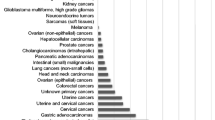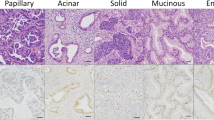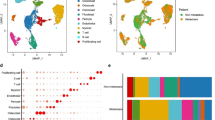Abstract
Background
The prognosis of lung cancer remains poor and clinically applicable prognostic markers have not yet been satisfactory identified. Several chromosomal copy number alterations (CNAs) have been associated with metastasis, relapse, and survival of patients with lung cancer; however, no study has focused exclusively on identifying CNAs at a gene level. The aim of this study was to identify genes whose CNAs are associated with survival of patients with lung adenocarcinoma.
Methods
The CNA status of a panel of 48 genes was detected by high-resolution array comparative genomic hybridization in 56 lung adenocarcinoma samples. The follow-up time of these patients was 8.5–65.7 months. The gene CNAs were analyzed for their association with patient survival.
Results
Cox univariate regression analysis revealed that EGFR gain (hazard ratio (HR) 3.84, 95% confidence interval (CI) 1.62–9.10), VHL loss (HR 4.56, 95% CI 1.85–11.27) and WWOX loss (HR 4.14, 95% CI 1.60–10.69) were each associated with poor survival. Multivariate analyses including EGFR gain, VHL loss and WWOX loss, as well as the clinicopathological variables such as age, sex, tumor size, tumor differentiation and TNM stage showed that EGFR gain (HR 4.63, 95% CI 1.69–12.7) and VHL loss (HR 4.82, 95% CI 1.41–16.43) were independent prognostic factors for poor survival, whereas WWOX loss lost statistical significance.
Conclusion
These findings suggest that EGFR gain and VHL loss are associated with poor overall survival for lung adenocarcinoma patients and may be used as prognostic markers.

Similar content being viewed by others
References
Lockwood WW, Chari R, Coe BP et al (2010) Integrative genomic analyses identify BRF2 as a novel lineage-specific oncogene in lung squamous cell carcinoma. PLoS Med 7:e1000315
Aggarwal C, Somaiah N, Simon GR (2010) Biomarkers with predictive and prognostic function in non-small cell lung cancer: ready for prime time? J Natl Compr Canc Netw 8:822–832
Jemal A, Siegel R, Ward E et al (2009) Cancer statistics, 2009. CA Cancer J Clin 59:225–249
Sun Z, Aubry MC, Deschamps C et al (2006) Histologic grade is an independent prognostic factor for survival in non-small cell lung cancer: an analysis of 5018 hospital- and 712 population-based cases. J Thorac Cardiovasc Surg 131:1014–1020
Mountzios G, Dimopoulos MA, Soria JC et al (2010) Histopathologic and genetic alterations as predictors of response to treatment and survival in lung cancer: a review of published data. Crit Rev Oncol Hematol 75:94–109
Bearz A, Berretta M, Cappellani A et al (2010) Biomarkers in lung cancer. Front Biosci (Elite Ed) 2:1099–1104
Speleman F, Kumps C, Buysse K et al (2008) Copy number alterations and copy number variation in cancer: close encounters of the bad kind. Cytogenet Genome Res 123:176–182
Vogelstein B, Kinzler KW (1993) The multistep nature of cancer. Trends Genet 9:138–141
Pinkel D, Albertson DG (2005) Array comparative genomic hybridization and its applications in cancer. Nat Genet 37(Suppl):S11–S17
Wrage M, Ruosaari S, Eijk PP et al (2009) Genomic profiles associated with early micrometastasis in lung cancer: relevance of 4q deletion. Clin Cancer Res 15:1566–1574
Tai AL, Yan WS, Fang Y et al (2004) Recurrent chromosomal imbalances in nonsmall cell lung carcinoma: the association between 1q amplification and tumor recurrence. Cancer 100:1918–1927
Boelens MC, Kok K, van der Vlies P et al (2009) Genomic aberrations in squamous cell lung carcinoma related to lymph node or distant metastasis. Lung Cancer 66:372–378
Gallegos Ruiz MI, Floor K, Roepman P et al (2008) Integration of gene dosage and gene expression in non-small cell lung cancer, identification of HSP90 as potential target. PLoS One 3:e0001722
Kim TM, Yim SH, Lee JS et al (2005) Genome-wide screening of genomic alterations and their clinicopathologic implications in non-small cell lung cancers. Clin Cancer Res 11:8235–8242
Goeze A, Schluns K, Wolf G et al (2002) Chromosomal imbalances of primary and metastatic lung adenocarcinomas. J Pathol 196:8–16
Barrett MT, Scheffer A, Ben-Dor A et al (2004) Comparative genomic hybridization using oligonucleotide microarrays and total genomic DNA. Proc Natl Acad Sci USA 101:17765–17770
Beroukhim R, Mermel CH, Porter D et al (2010) The landscape of somatic copy-number alteration across human cancers. Nature 463:899–905
Ma C, Quesnelle KM, Sparano A et al (2009) Characterization CSMD1 in a large set of primary lung, head and neck, breast and skin cancer tissues. Cancer Biol Ther 8:907–916
Peralta R, Baudis M, Vazquez G et al (2010) Increased expression of cellular retinol-binding protein 1 in laryngeal squamous cell carcinoma. J Cancer Res Clin Oncol 136:931–938
Savola S, Klami A, Tripathi A et al (2009) Combined use of expression and CGH arrays pinpoints novel candidate genes in Ewing sarcoma family of tumors. BMC Cancer 9:17
Threadgill DW, Dlugosz AA, Hansen LA et al (1995) Targeted disruption of mouse EGF receptor: effect of genetic background on mutant phenotype. Science 269:230–234
Sibilia M, Wagner EF (1995) Strain-dependent epithelial defects in mice lacking the EGF receptor. Science 269:234–238
Onn A, Correa AM, Gilcrease M et al (2004) Synchronous overexpression of epidermal growth factor receptor and HER2-neu protein is a predictor of poor outcome in patients with stage I non-small cell lung cancer. Clin Cancer Res 10:136–143
Swinson DE, Cox G, O’Byrne KJ (2004) Coexpression of epidermal growth factor receptor with related factors is associated with a poor prognosis in non-small-cell lung cancer. Br J Cancer 91:1301–1307
Chang JW, Liu HP, Hsieh MH et al (2008) Increased epidermal growth factor receptor (EGFR) gene copy number is strongly associated with EGFR mutations and adenocarcinoma in non-small cell lung cancers: a chromogenic in situ hybridization study of 182 patients. Lung Cancer 61:328–339
Gandhi J, Zhang J, Xie Y et al (2009) Alterations in genes of the EGFR signaling pathway and their relationship to EGFR tyrosine kinase inhibitor sensitivity in lung cancer cell lines. PLoS One 4:e4576
Varella-Garcia M, Mitsudomi T, Yatabe Y et al (2009) EGFR and HER2 genomic gain in recurrent non-small cell lung cancer after surgery: impact on outcome to treatment with gefitinib and association with EGFR and KRAS mutations in a Japanese cohort. J Thorac Oncol 4:318–325
Davidowitz EJ, Schoenfeld AR, Burk RD (2001) VHL induces renal cell differentiation and growth arrest through integration of cell-cell and cell-extracellular matrix signaling. Mol Cell Biol 21:865–874
Pause A, Lee S, Lonergan KM et al (1998) The von Hippel-Lindau tumor suppressor gene is required for cell cycle exit upon serum withdrawal. Proc Natl Acad Sci USA 95:993–998
Chitalia VC, Foy RL, Bachschmid MM et al (2008) Jade-1 inhibits Wnt signalling by ubiquitylating beta-catenin and mediates Wnt pathway inhibition by pVHL. Nat Cell Biol 10:1208–1216
Mikhaylova O, Ignacak ML, Barankiewicz TJ et al (2008) The von Hippel-Lindau tumor suppressor protein and Egl-9-Type proline hydroxylases regulate the large subunit of RNA polymerase II in response to oxidative stress. Mol Cell Biol 28:2701–2717
Young AC, Craven RA, Cohen D et al (2009) Analysis of VHL gene alterations and their relationship to clinical parameters in sporadic conventional renal cell carcinoma. Clin Cancer Res 15:7582–7592
Cai Q, Robertson ES (2010) Ubiquitin/SUMO modification regulates VHL protein stability and nucleocytoplasmic localization. PLoS One 5:e12636
Peng Z, Shan C, Wang H (2009) Expression of VHL and HIF-1alpha and its clinical significance in the lung cancer tissue. Zhong Nan Da Xue Xue Bao Yi Xue Ban 34:331–334
Shen H, Gao W, Wu YJ et al (2009) Multicolor fluorescence in situ hybridization and comparative genomic hybridization reveal molecular events in lung adenocarcinomas and squamous cell lung carcinomas. Biomed Pharmacother 63:396–403
Yu S, Bittel DC, Kibiryeva N et al (2009) Validation of the Agilent 244K oligonucleotide array-based comparative genomic hybridization platform for clinical cytogenetic diagnosis. Am J Clin Pathol 132:349–360
Adati N, Huang MC, Suzuki T et al (2009) High-resolution analysis of aberrant regions in autosomal chromosomes in human leukemia THP-1 cell line. BMC Res Notes 2:153
Staaf J, Jonsson G, Ringner M et al (2010) High-resolution genomic and expression analyses of copy number alterations in HER2-amplified breast cancer. Breast Cancer Res 12:R25
Acknowledgments
This work was supported by the Heilongjiang Science Foundation for Young Scholar (No.QC2009C14).
Conflict of interest
None of the authors have any conflicts of interest.
Author information
Authors and Affiliations
Corresponding author
Additional information
Drs. Y. Zhao and Y. Li contributed equally to this work.
About this article
Cite this article
Zhao, Y., Li, Y., Wang, S. et al. The relationship between EGFR gain and VHL loss in lung adenocarcinoma and poor patient survival. Int J Clin Oncol 16, 679–685 (2011). https://doi.org/10.1007/s10147-011-0248-9
Received:
Accepted:
Published:
Issue Date:
DOI: https://doi.org/10.1007/s10147-011-0248-9




